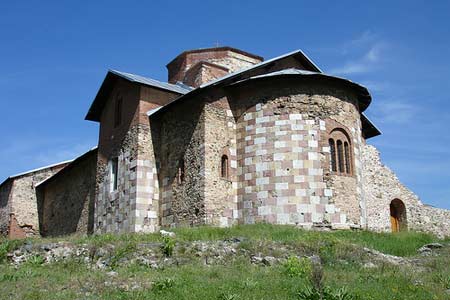View Larger Map
Banjska Monastery, the royal sepulchre of the Serbian King Stefan Uros II Milutin (one of the most powerful Balkan rulers of the period and one of the most powerful rulers of the entire Nemanjic dynasty) is located near the village of Banjska in Zvecan municipality, north of Kosovska Mitrovica.
 |
| Aerial view |
 |
| King Milutin |
 | |
| King Milutin's Relics |
The monastery church, dedicated to the Holy Archdeacon Stefan, was built in the same location where the seat of the Banjska diocese existed in the 13th century, during the rule of Milutin's father, King Uros I. During Milutin's reign the monastery was restored between 1313 and 1316 and became the fourth most important monastery in the Serbian Archdiocese. When the Holy King Milutin passed away in his summer palace in Nerodimlje (near Urosevac) in the year 1321, Archbishop Danilo II (appointed builder of the shrine) transferred his body to Banjska where he was buried with full royal honours. However, following the Battle of Kosovo in 1389 his body was moved to Trepca and then in 1445 to Sofia, in Bulgaria, in the church of St. Alexander Nevsky, awaiting its return to Banjska once more.
The monumental building with its church, library, monks' quarters and "imperial palace" began to fall into disrepair very quickly. At the beginning of the 15th century, a fire destroyed the library and in the second half of the same century the monastery is presumed to have been abandoned. During the 17th century the Turks desecrated the holy site and transformed the church of Banjska Monastery into a mosque. The monastery suffered great destruction in 1689 when the Turkish and Austrian armies alternately used it as a fortress during the Austrian-Turkish War.
 |
| Queen Theodora’s Ring |
At the end of the 17th century the Turks dug up the marble floor of the church in a sacrilegious quest to find the gold of Archbishop Danilo. The first more serious investigations began immediately after the liberation of Kosovo and Metohija in 1912. In 1915 two gold rings were found in the grave of Queen Theodora, the mother of the Emperor Dusan, later buried in the northern chapel of the church. These rings are considered to be the most beautiful examples of Serbian medieval jewellery: one of them is adorned with an antique cameo and the other contains the image of a heraldic eagle with the inscription “Who wears this, God bless them”. The cameo ring is held by the family of the famous collector Ljubomir Nedeljkovic, and the heraldic ring is preserved in the National Museum in Belgrade. In 1938, after the end of the investigation and the digging up of the foundations of the surrounding residence halls, the church was partially restored and placed under a temporary roof.
The monastery was granted a large estate at its founding, a profitable grant of 75 villages and 8 pastures. According to medieval sources, as well as oral tradition, Banjska was one of the most beautiful Serbian monasteries, built in the style of the Raska School, using the plan of the church of the Theodokos in Studenica as a model, specifically requested by King Milutin.
The base of the church consists of a single nave building with the monumental apse and chapels on both sides of the main nave. The portal on the west side was adorned with two monumental towers.
The exterior is decorated with a combination of tricoloured marble as well as rich stone sculptures. The most significant preserved sample, a relief sculpture of the Theodokos with Christ that decorated the main portal, is today located in the nearby Sokolica Monastery. Only fragments presenting the saints in arched medallions under the main cupola from the rich frescoes done during the period from 1317 to 1321 have been preserved.
 |
| Exterior |
Banjska Monastery was declared Monument of Culture of Exceptional Importance in 1990, and it is protected by the Republic of Serbia.

No comments:
Post a Comment